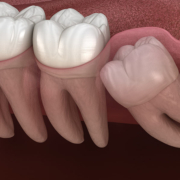Wisdom teeth (3rd molars) normally erupt between 17 and 25, hence the name.
A very long time ago, they were very useful in helping us break down foliage, but are now they are pretty vestigial. There may be several reasons for this. Our more refined diet has led to much less wearing down between the teeth (which helped to make room at the back) and there has also been a reduction in jaw size with this softer diet, and yet our teeth have not significantly changed in size to adapt to this.
Every week I hear Wisdom teeth being accused of causing incisor teeth to crowd up. There is lots of evidence comparing people with wisdom teeth and those missing wisdom teeth that have shown they all have identical amounts of crowding so Wisdom teeth are at least vindicated of this crime.
These days Wisdom teeth seem to rarely fit in properly leaving them unerupted or partly erupted and hard to clean right at the back. NICE (National Institute of Clinical Excellence) produced guidelines in 2000 limiting the cases in which wisdom teeth can be removed to mostly cases where the wisdom tooth is diseased or where it is causing other problems with the mouth. That is very different from the approach 20 years ago when I was relieved of all four of my symptomless and unerupted wisdom teeth under General Anaesthetic!



